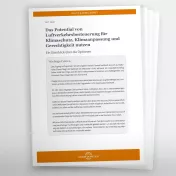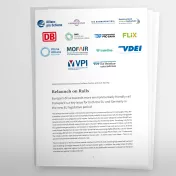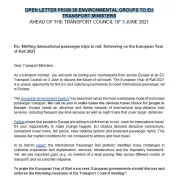- Abstract
- Situation of Rail in the 1990‘s
- Local passenger transport
- Long distance passenger transport
- Freight transport
- Climate Impact of Railways
The share of rail in global transport has been continuously decreasing since the beginning of the 20th century and today it is considerably lower than the share of road traffic. However, with appropriate structural changes rail could drastically improve its performance in local and long distance passenger transport as well as in freight transport.
To achieve this for local passenger transport, changes in policy and planning (e.g., increased introduction of the buyer principle, priority for light rail at intersections), innovative design of vehicles (e.g., Dual System Light Rail) and a better integration with other transport modes would be necessary.
In long distance passenger transport, passengers could be shifted from air traffic to high speed trains. However, this would require great investments.
Important changes to strengthen freight transport could be made in Europe by improving the cooperation of rail and road, enabling a stronger competition in this market and internalising external costs for all modes of transport.
The shifting of demand towards rail can make a considerable contribution to climate protection, because in almost all cases rail is several times more climate friendly than road and air transport.
Situation of Rail in the 1990‘s
After its introduction in the 1830‘s, rail transport has dominated motorised land transport for nearly a century. Then most governments directed their investments towards roads with a declining importance of rail in consequence. Nowadays rail has high market shares only in some countries (e.g. passenger transport in Japan, China and India, freight transport in Northern America, Russia and China). World freight transport on railways decreased sharply after the breakdown of the Soviet Union. Globally, at the end of the 20th century 1800 billion (1.8 * 1012) passenger-kilometers and 5700 billion ton kilometers per year took place on the 900 000 km long global rail network. In passenger transport rail has 8 percent of the global market.
The rail system has a cost structure different from road transport. For the latter infrastructure costs are 20 percent or less of total system cost (i.e. for roads, vehicles, driving and insurance; external costs are not included), whereas for rail the costs of the infrastructure often are more than half of the total cost. This means that the development of railways is difficult in times when public money is scarce.
Rail plays an important role in local and long distance passenger transport as well as in freight transport. However, in all of these three fields it can drastically improve its performance.
The vast majority of rail customers use trains in local passenger transport. Rail is the most advantageous and often the only possible means of transport for high passenger flows (e.g. in Tokyo, rail has 60 percent of modal share). But as it can be fast and comfortable, in some countries (e.g. in Switzerland and parts of Germany) the rail network covers also rural areas with high quality standards (i.e. a train at least every hour from 6 a.m. to 9 p.m. every day).
The introduction of the "buyer principle" in several countries (regional authorities received resources for ordering trains to run regularly because they are rarely profitable) introduced competition and led to higher quality and lower costs.
There is a distinction between heavy and light rail. Heavy rail can also be used by freight trains, it has a strict operational scheme (concerning signaling and safety issues) and it is therefore expensive compared to light rail which is designed for transport needs in cities. The tramway is an example for light rail. After separating most of its track from car lanes and giving priority to it in intersections with other roads it has experienced a global renaissance since the mid 1980s (e.g. in France, three completely new systems opened in the year 2000 in Montpellier, Orléans and Lyon).
An innovative and very successful approach is the so-called "Dual System Light Rail" (first introduced in Karlsruhe in 1992). This is a Light Rail Vehicle which uses tram tracks in the city center. After leaving the city it enters the tracks of the conventional rail network (which has existed for more than a century) and thus links rural areas with the city center without the need for passengers to change trains. Another huge advantage is that nearly no new infrastructure has to be build (which takes decades and is very expensive).
An important precondition for increased demand in local trains and light rail is the integration of bus connections (e.g. "feeder buses") in railway planning as well as through ticketing (the same ticket for bus, metro and train).
Long distance passenger transport
The introduction of Japanese Shinkansen high speed trains in 1964 and the French "Train à Grande Vitesse" (TGV) in 1981 brought a new generation of long distance passenger trains into life which had doubled speed compared to the older trains and to cars. Subsequently, high speed lines have been built in Italy, Germany, Spain, Belgium, in the UK and in Sweden. In South Korea, Taiwan and China they are under construction. With such trains (and the corresponding infrastructure) rail can be the strongest competitor up to distances of 600 km. E.g. between Paris and Brussels (310 km distance) the market share of rail is 10 times higher than the share of air traffic.
A further expansion of the European high speed network is under way, but it can only be supplemental to conventional lines because of high investment costs.
Global demand for rail passenger transport showed high growth rates in the late 90‘s which is mainly due to high populated countries like India and China. Demand for rail (in passenger-kilometers travelled) rose by nearly 5 percent in 1999 compared to the year before.
Rail is – together with inland waterways - very appropriate to transport high amounts of (homogeneous) goods over long distances. This explains why big countries with high transport volumes like the USA, Russia or China have high shares in rail freight traffic (at the end of the 1980s in the Soviet Union 4000 billion tkm freight was carried per year).
Global rail freight has also shown a growth (in tkm) of 5 percent in 1999.
But for post-industrial societies where the service sector becomes more and more important (and the size of transported goods diminishes) the structure of rail freight services has to be modified. Cooperation with the competitor on the road is necessary to enter in these growing markets. Competition of different rail companies in the rail network could improve the quality of freight transport. New technical solutions have to be introduced.
But rail freight will have no broad success as long as political decisions which introduce appropriate framework conditions (e.g. internalising of external costs) to support climate friendly technologies (like rail) are missing.
A general political target could be e.g. that a certain percentage of future growth of freight transport should be carried by rail. In case that this target won’t be achieved this is a signal to decision makers to introduce further measures to strengthen rail transport.
In late 2000, the German Government proceeded a little differently and formulated a target of doubling rail freight (in tkm) until the year 2015.
For climate policy, transport is probably the sector where limitation and reduction of greenhouse gas emissions is most difficult to achieve.
Rail is a relatively climate friendly mode of transport. In Europe the majority of trains are powered by electric engines, the electricity coming from the catenary. In countries like Switzerland, Sweden or France this implies nearly no CO2-emissions because of their electricity generation patterns (renewables and nuclear; the disadvantages of the latter cannot be discussed here). Other countries could change their electricity procurement (e.g. like in Sweden where the railway only uses electricity from renewables) if climate protection gets a higher priority.
But even in rural areas with lower passenger volumes and diesel powered engines the ecological performance of trains (driving e.g. 18 times a day in one direction) are better than those of cars (average occupation considered) if there are more than 200 passengers per day and direction (which is not much) and appropriate vehicles are used.
Although no general data can be given because of different local and regional performances, there is evidence that nearly always (passenger as well as freight) rail transport is several times more climate friendly than road transport (and, of course, than aviation).
Manfred Treber
February 2001
(also available in German, see 01-2-01)


